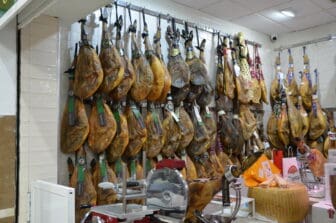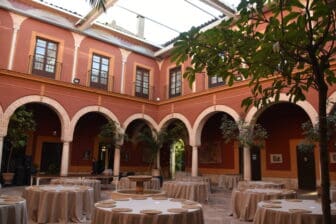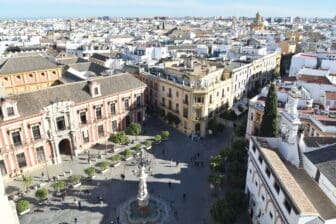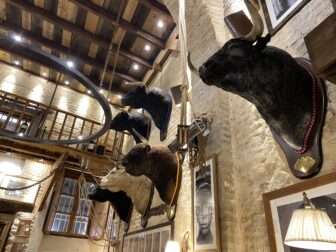
[Nov. 2021] The next day, we checked out the inn in Ecija in the Andalusia region of Spain, left our luggage, and went for a walk.
This inn, Casa en el Centro, cost 50 euros without meals.

I felt that I was able to experience a little bit of the life of a traditional house, and I think it was a good value.
On this day, we first visited the library on the southwest corner of Plaza de Espana, the central square.
We didn’t plan to go in here, but when we took a peek, the person in charge beckoned us, so we went in.
The library was also housed in a large house with the patio and the patio was used as the main place.
The ceiling of the patio was made of glass, and from there we could see the bell tower of the church of Santa Maria next door.

Casa Palacio de los Pareja is the name of the library building and may have once been the mansion of a noble man.
The church of Santa Maria was still closed, so we left the area and headed north of Plaza de Espana.
We noticed there was an indoor market, so we went in.
It was quite busy and we could see that it was an important shopping spot for locals.

I noticed countless hanging hams and delicious looking mushrooms.
By the way, just north of the province of Seville in Andalusia, where we visited this time, is the state of Extremadura, which is a famous production area for Iberian pigs and ham.
After leaving the market, we headed toward the square with the church of Santa Cruz, which we visited the day before, and turned right on the road in front of it, then we found a mansion called Casa Palacio de Palma.
This is the place recommended by the person at the tourist information centre.

It is now a museum, but the feature is that old furniture is displayed as it was so that you can get a glimpse of their life in the past.
At first, the gate was closed, but the cleaner called the person in charge and let us in.
This man in charge took us around the house explaining many things.
He was very enthusiastic, but unfortunately we could only get some small parts of what he was saying because he only spoke Spanish.
What we understood was that this mansion was originally a monastery.
And then it was used as a mansion for aristocrats and then used by the military, but after that it was left unattended for a while.

After restoration, it is now a museum and also used as a space for parties to maintain the building.
It was worth seeing, with the Mudejar ceiling, the traditional doors that are unique to the region and so on.
The entrance fee was 3 euros per person, but because we were impressed by the enthusiasm of this man, we gave him a tip.
He looked confused, though.
When you get out of there, it was about time.
The day before, we had booked a taxi through a tourist information centre.
So we returned to the inn to pick up our luggage and went to the front of the museum to meet the taxi driver.



